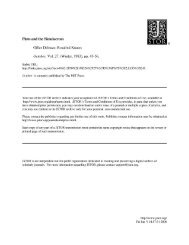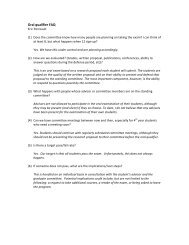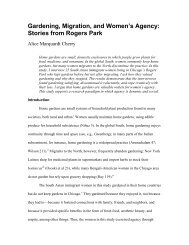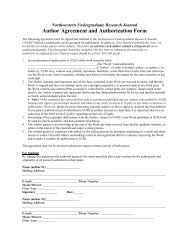research - Associated Student Government, Northwestern University
research - Associated Student Government, Northwestern University
research - Associated Student Government, Northwestern University
Create successful ePaper yourself
Turn your PDF publications into a flip-book with our unique Google optimized e-Paper software.
RESEARCHSection VII. ConclusionThis paper used data on US-China trade since 1984 to study the effects of an appreciation of the Renminbi on thetrade balance as well as the real GDP’s of the two countries. The topic of US-China trade has come under increasedscrutiny over the past couple years since the US trade deficit has ballooned. Still, there is no consensus on what theprecise effects of an appreciation of the RMB would be. While the results of this paper support the hypothesis that anappreciation of the RMB would significantly decrease the magnitude of the US-China trade balance, they also showthat China’s export sector and overall economy would suffer. However, in the medium term this might be a positivedevelopment in so far as it helps China control inflation and achieve its goal of decreasing its reliance on foreigndemand for economic growth. Regardless, this analysis does not suggest that China should allow the RMB to float;an evaluation of the merits of floating is beyond the scope of this paper. Additionally, as suggested by the impulseresponse analysis, an appreciation of the RMB would have significant though limited benefit for the US economy.It also suggests that the rest of the OECD might have the most to gain from an appreciation of the RMB due to thesubstitution to their goods and away from Chinese goods. The significant positive effect on the real GDP of boththe US and the rest of the OECD that has been withheld by the Chinese government’s refusal to allow the RMB toappreciate indicates that these policies should be considered mercantilist and treated as such.From the US perspective, this study emphasizes that the US government should not expect China’s appreciationto be the magic impetus that revives the US economy. Indeed, the analysis indicates that the full effects of a gradualappreciation will only be felt over a period of 2-4 years. Thus, more focus should be placed internally on job creationinstead of placing blame externally, especially since this has proved to be counterproductive in dealing with a Chinesegovernment determined not to appear influenced by the US. From the Chinese perspective, an appreciation willhave some negative effects on its real GDP growth rate, but it will have many positive side effects. These includethe beginning of a shift from reliance on exports to an economy driven by domestic demand, which would make itless vulnerable to foreign economic shocks. The appreciation would also help control domestic inflation and assetbubbles that can be particularly dangerous to China’s economy given the frailty of the banking sector. Finally, itwould aid in decreasing the income gap between the upper class that includes the owners of exporting firms thatare benefitting from the undervaluation of the RMB to the average Chinese consumer who is still quite poor despitethree decades of rapid economic growth.In order to inform policy decisions in the future and in other areas, further <strong>research</strong> is necessary on the effects ofa floating exchange rate using the vector error correction models that I use in my paper. In addition, improvementsin data collection are essential in ensuring the accuracy of these future studies. More <strong>research</strong> will decrease theuncertainty associated with international trade and allow consumers and companies across the world to makeinvestment decisions more efficiently, thereby increasing economic growth rates.ReferencesAhmed, Shaghil. “Are Chinese Exports Sensitive to Changes in the Exchange Rate?” International Finance Discussion Papers. Vol. 987 (2009).Bahmani-Oskooee, M. “Nominal and Real Exchange Rates of the Middle Eastern Countries and their Trade Performances.” Applied Economics. Vol. 33 (2001): 89-96.Baxter, Marianne, and Alan C. Stockman. “Business Cycles and the Exchange Rate Regime.” Journal of Monetary Economics. Vol. 23 (1989): 377-400.Breslin, Shaun. “Reforming China’s Embedded Socialist Compromise: China and the WTO.” Global Change, Peace, and Security. Vol. 15, Iss 3 (2003): 213-229.Bussière, Matthieu and Schnatz, Bernd. “Evaluating China’s Integration in World Trade with a Gravity Model Based Benchmark.” Open Econ Rev. Iss 20 (2009): 85–111.Dyer, Geoff. “FT.com / China - Beijing Studies Severing Peg to US dollar.” 11 Mar 2010.Edwards, S. Real Exchange Rates, Devaluation, and Adjustments: Exchange Rate Policy in Developing Countries. Cambridge Mass: MIT Press, 1989.Faruqee, Hamid. “Measuring the Trade Effects of EMU.” IMF Working Paper. 04/154. (2004)“Flawed Study on China Jobs, Focus on Currency Distract from Real Issues, USCBC Says.” Retrieved 30 Mar 2010 from .Frankel, Jeffrey. “On the Renminbi: The Choice Between Adjustment Under a Fixed Exchange Rate and Adjustment Under a Flexible Rate.” Seminar on Foreign Exchange System, Dalian, China,May 26-27, 2004.French, Shaun, Andrew Leyshon, and Nigel Thrift. “A Very Geographical Crisis: The Making and Breaking of the 2007-2008 Financial Crisis.” Cambridge Journal of Regions, Economy and Society.Vol 2, Iss 2 (2009): 287-302.Houthakker, H. S., and Stephen P. Magee. “Income and Price Elasticities in World Trade.” The Review of Economics and Statistics. Vol. 51, No. 2 (1969): 111-125.Hsing, Yu. “A Study of the J-Curve for Seven Selected Latin American Countries.” Global Economy Journal. Vol. 8, Iss. 4 (2008): Article 6.Krugman, Paul et al. “The Persistence of the U.S. Trade Deficit.” Brookings Papers on Economic Activity. Vol. 1 (1987).Liu, Chinhui and O’Farrell, Grace. “China and U.S. Financial Ratio Comparison.” International Journal of Business, Accounting, and Finance. Vol. 3, No. 2 (2009).Makin, Anthony J. “The Inflexible Yuan and Global Imbalances.” Global Economy Journal. Vol. 8, Iss. 3 (2008): Article 7.Marquez, Jamie and John Schindler. “Exchange Rate Effects on China’s Trade.” Review of International Economics. Vol. 15, No. 5 (2007): 837-853.MacKinnon, J.G. “Critical Values for Cointegration Tests.” in R.F. Engle and C.W.J. Granger (eds.), Long-Run Economic Relationships. Oxford <strong>University</strong> Press, Oxford : 1991. 267-276.Morrison, Wayne. “China-U.S. Trade Issues,” CRS Report for Congress. September 2009.Narayan, Paresh and Seema Narayan. “Estimating Income and Price Elasticities of Imports for Fiji in a Cointegration Framework.” Economic Modeling. Vol. 2, Iss. 2 (2005): 423– 438.Nelson, Charles R., and Charles I. Plosser, “Trends and Random Walks in Macroeconomic Time Series: Some Evidence and Implications.” Journal of Monetary Economics. Vol. 10 (1982): 139-162.Obstfeld, Maurice, and Kenneth Rogoff. “The Mirage of Fixed Exchange Rates.” The Journal of Economic Perspectives. Vol. 9, Iss. 4 (1995): 73-96.Reinhart, C. M. “Devaluation, Relative Prices and International Trade – Evidence from Developing Countries.” IMF Staff Papers. Vol. 42 (1995): 290-312.Roberts, Ivan and Rod Tyers. “China’s Exchange Rate Policy: The Case for Greater Flexibility,” Asian Economic Journal. Vol. 17, No. 2 (2003).24 NORTHWESTERN UNDERGRADUATE RESEARCH JOURNAL











